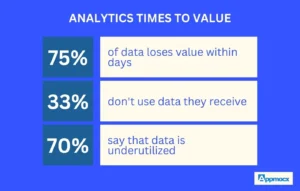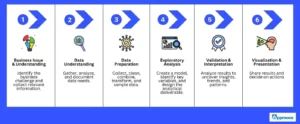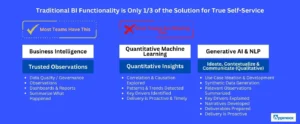Unlocking Data Potential: Overcoming Deterioration and Inefficient Analytics
Recent findings from IDC research reveal statistics that underscore the importance of tackling this issue.
- 75 percent of data becomes less valuable within days.
- 33 percent of the data that’s available remains unused.
- 70 percent of companies say they are not fully using their data effectively.
The importance of these observations highlights the requirement for teams to enhance their strategies in handling and utilizing data effectively to produce outcomes promptly.

One major problem is data deterioration; as stated by IDC, 75 percent of data becomes less valuable in a matter of days. Additionally, 33 percent of companies do not effectively use the data they gather. Artificial Intelligence and BI can play a pivotal role in addressing these challenges by unlocking actionable insights. 70 percent acknowledge that they do not fully utilize their existing data.
Businesses have dedicated resources to data and analytics, in forms like technology upgrades, consultancy services and recruiting expert personnel over time. Despite these endeavors persistent obstacles remain. Upon examination of the data, it is clear that there is a bottleneck in the analytics workflow. Specifically the last phase, producing reports and extracting insights. It still heavily relies on manual labor, which hampers overall operational efficiency.
The last mile bottleneck
The bottleneck often occurs in the phase due to a lack of understanding of the work and steps needed to move from data to useful business knowledge effectively. The general perception is that dashboards and conventional BI tools are the fix; however, this belief is not entirely accurate. Sometimes a dashboard might be enough. Most of the time it serves as a part of a broader system that relies significantly on manual inputs.
Dashboards and conventional business intelligence tools might occasionally present and visualize information in a manner that addresses the queries of a business decision maker and helps propel them in their decision making process. Nonetheless it is frequently used as a step for delving deeper into data—a mere component of a larger and more thorough analytical process.
Misconceptions about Data Exploration

Three Common Misconceptions About Dashboards That Challenge Analytics Teams
Misconception #1: “We know exactly what we need, and analytics teams can deliver it.”
The Reality: The truth is that it’s not common to know what we want from the start, our ideas tend to change as they develop. We often seek feedback and make revisions to improve the solution, over time.
Misconception #2: “A dashboard will provide all the answers, eliminating further questions.”
The Reality: The truth is that dashboards usually mark the starting point than the end result of inquiry as they tend to raise questions and encourage more thorough exploration.
Misconception #3: “Building the dashboard is the end of the process.”
The Reality: The process of turning data into insights goes beyond just creating dashboards, it involves brainstorming ideas, conducting investigations, answering queries, discovering insights and conveying results effectively.
The common thread among these three misunderstandings is that they all create obstacles, to underestimating the time needed to complete the process of gaining insights.

The obstacle often refers to as the BI Bottleneck is a struggle, for businesses out there. You know what? We think there’s a solution to break free from it and that’s automation! The way we’ve been tackling this problem far has been lacking in some aspects. Dashboards and conventional BI tools, whether they’re used for crunching numbers on metrics or displaying data through bullet charts or heat maps. They are great for summarizing and reporting business insights. But here’s the thing, they only cover a portion of the solution.
One third of the analysis focuses on information and delves into analytics to address business queries such as recognizing relationships, causes and uncovering significant factors or trends within the data set. Understanding cause and effect is a concern as it forms the basis of many business choices. Although these insights can be extracted manually using spreadsheets or with the aid of data experts, automation plays a role in enhancing efficiency and scalability—making it a significant game changer.
The last third is what I call observations. Here is where generative AI comes in handy. Not as a replacement for insights but as a game changer in BI automation. We’ve witnessed AI transform the landscape over the eighteen months especially as it generates scenarios tailored to specific business users according to their roles or sectors.
One other important aspect involves natural language processing (NLP) and natural language generation (NLG). These tools allow AI to create stories, from information by explaining the context of the data presented in numbers effectively and objectively using automation and machine learning techniques, without biases involved in data interpretation to deliver precise actionable insights driven by AI intelligence.
The comprehensive method that integrates dashboards along with both qualitative insights play a role in overcoming the BI Bottleneck and unleashing the complete capabilities of your data.
Enhanced BI and Analytics
When these methods are put together, we get what Gartner calls augmented BI and analytics —improving BI with AI powered automation to reveal the stories concealed in data. Nevertheless, remember that this approach doesn’t completely automate the procedure. Business professionals still have a role in examining data curating valuable insights and crafting engaging narratives. What it does automate are tasks that tend to be highly technical and require skills or those that are time consuming and tedious when carried out manually.
Lets now delve into how AI and automation can tackle misunderstandings and remove the bottlenecks that impede the delivery of business intelligence:
Bottleneck #1:
People often think that we have an idea of what we want and believe that analytics tools can meet our needs flawlessly without any help or direction.
Initiating Solution/ Automation Potential Guide, for Beginners:
Lets utilize AI and Machine Learning capabilities to act as a guide in finding the solutions we seek.Generative AI can be incredibly useful in suggesting applications for individuals, from the start.
For instance, in Auto Insights Playbooks feature; Users start with a dataset and Playbooks examine its format and themes to propose valuable applications within Auto Insights automatically generate a report based on the user’s choices This procedure converts raw data into practical insights and engaging data narratives in less, than five minutes.
What should you do if you don’t have any data to begin with? Playbooks has a solution for this well! By using a driven interface where users can input details like their job position or industry sector or company name, Playbooks can suggest tailored applications for them based on these inputs. With just a few clicks on the interface users can develop a prototype rapidly that comes with an artificial data structure, within just five minutes.
This smooth process guarantees that individuals can swiftly access the power of data driven insights no matter where they begin from.
Bottleneck #2:
Many people believe that once a dashboard is created all questions are answered and no further inquiries are necessary.
Exploring the Potential of AI in Providing Quantitative Insights:
Utilize AI and Machine Learning to effectively discover patterns and insights in data without any biases or the need for intervention. Once the data is input into the system these technologies can automate tasks typically done by analysts or data scientists. This proactive method addresses business inquiries such as:
- What were the main reasons behind the growth in revenue this month?
- Which products made up the 20 percent that generated 80 percent of my revenue?
- Which call centers saw the increase in call volume this month?
By incorporating AI generated insights into their operations dashboards to embrace more dynamic and actionable intelligence for better decision making, in their businesses.
Bottleneck #3:
A common misunderstanding is that creating the Dashboard encompasses the process.
Some people believe that finishing a dashboard means the insights are all set and done however there’s more to it than meets the eye.
Automation has the potential to revolutionize tasks that demand knowledge or involve time consuming activities that are intricate, in nature. Here are some prime areas ready, for automation:
- Generating ideas for applications automatically
- Enhancing the process of prototyping and designing data models.
- Streamlining the creation of initial report drafts.
- Analyzing patterns and trends, identifying drivers automatically.
- Analyzing correlations with ease.
Transferring analysis from one type of communication to another can be quite tedious when generating insights since many analysts spend a lot of time copying and pasting dashboard visuals into PowerPoint presentations repeatedly. A task that can take up time. Thankfully though Auto Insights provides a solution to this issue.
Magic Documents uses AI technology to automate communication by providing reliable analytical insights directly to stakeholders, in enterprises. By utilizing the text generation features of GPT models and effectively creating engaging content, for emails. PowerPoint presentations. This approach not saves time. It also guarantees effective and professional communication of important insights.
Conclusion
The incorporation of intelligence and automation into Business Intelligence (BI) procedures presents an answer to the challenges that have historically impeded analytics teams’ progress for a long time now. By dispelling misunderstandings about dashboards and data exploration techniques AI facilitates companies in streamlining their operations, lessening interventions and unlocking valuable insights more effectively. The capability to automate tasks, like report generation, pattern recognition and sharing findings not hastens decision making processes but also empowers teams to concentrate on strategic and high value tasks. In the realm of business intelligence (BI) as companies increasingly leverage AI technology advancements they should anticipate improved data utilization efficiency and quicker access, to insights while adopting a strategy to address evolving business needs effectively. Embracing AI based BI solutions offers a way for businesses to tackle obstacles and gain an edge in todays data centric landscape.